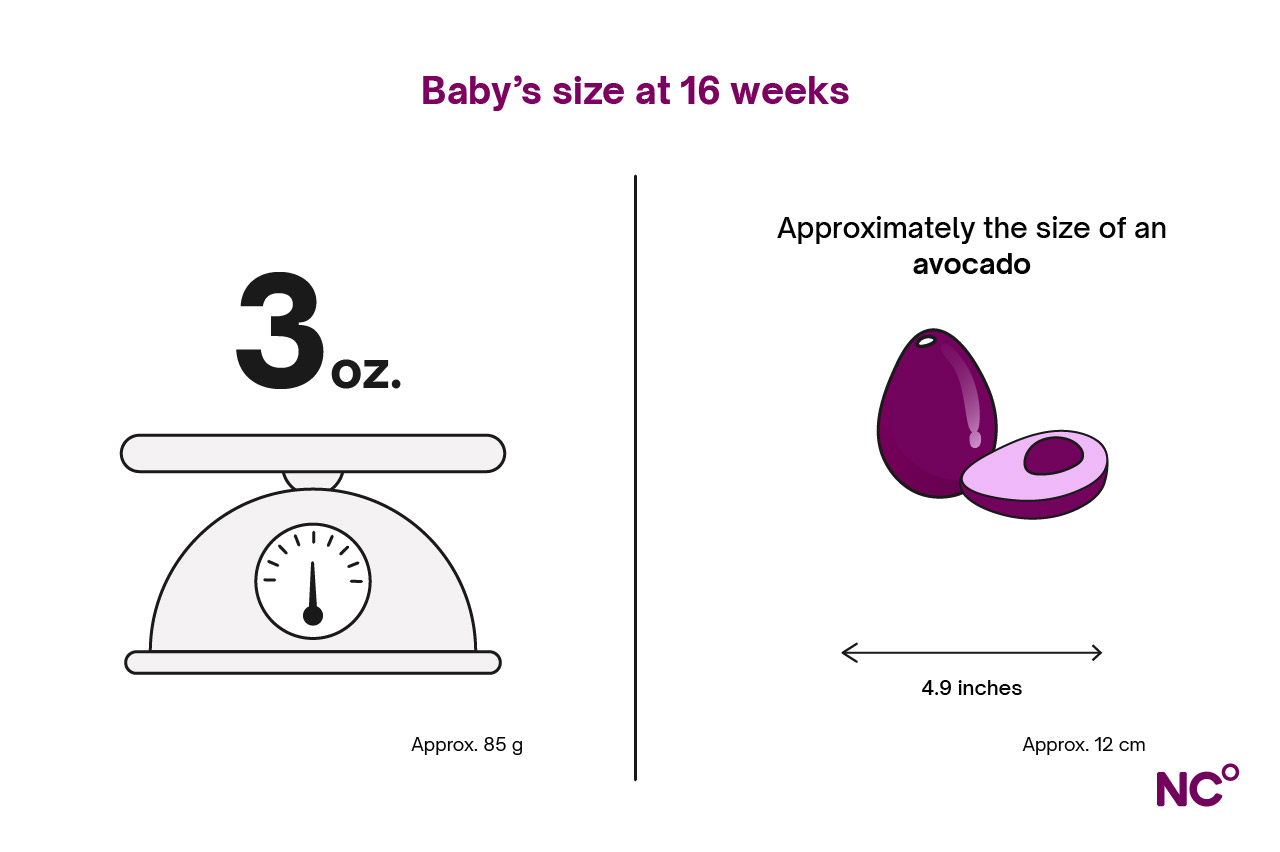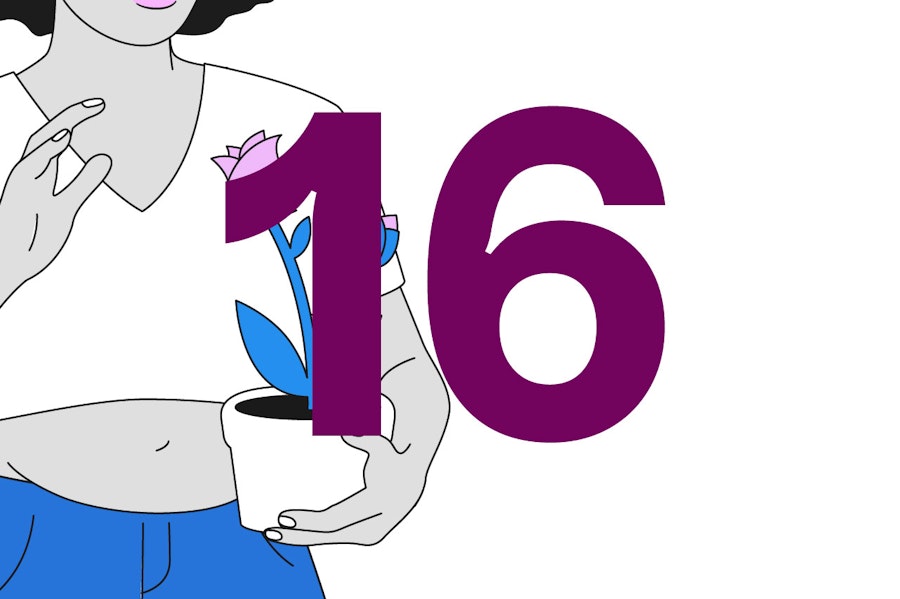16 Weeks pregnant: Baby development, symptoms and signs
Follows NC° Editorial Policy
At Natural Cycles, our mission is to empower you with the knowledge you need to take charge of your health. At Cycle Matters, we create fact-checked, expert-written content that tackles these topics in a compassionate and accessible way. Read more...
Key takeaways:
- Hormonal and physiological changes are linked to skin changes like acne during pregnancy, which might become more noticeable around week 16
- When sitting or relaxing try, to see if you can feel quickening, another name for your baby’s first movements
- Pain and discomfort in your back, pelvis, and hips are unfortunately common in the second trimester, and familiarizing yourself with the different types can help you find treatments and relief
At week 16 you are soon approaching the half-way point of your pregnancy! In this week’s guide, we will talk about changes in your body and some pregnancy symptoms you might experience in week 16. We will also check in on how your baby is doing and offer some tips for things you can do to take care of your mind and body.
Your body at week 16
Changes to your nipples and areolas
In the second trimester, you can expect to experience changes to your nipples and the surrounding skin, which is known as the areola. First, the color of your nipples and areola can get darker. The cause is melasma, which we talked about last week in the 15 Weeks pregnant guide. Hyperpigmentation, which is a darkening of skin tone caused by an increase in melatonin, is the most common skin change during pregnancy and typically comes in the second trimester. Areas of the body that are already darker, like the nipple areola, are more commonly affected by hyperpigmentation [1].
You also might see small bumps develop on your areolas, which are known as Montgomery tubercles. These small papules, or raised spots, are oil producing glands that provide lubrication to the nipples and areolas during breastfeeding.
Finally, your areolas might get larger and your nipples can become more erect. All of these physical changes occur because of hormonal and metabolic changes that support the development of your baby and the breast milk-producing mechanisms in your body [1]. Most changes resolve during your postpartum recovery. If you are concerned about any changes you observe, contact your healthcare provider.
Acne in week 16
Acne is a skin condition where dead skin and the skin’s naturally produced oils clog hair follicles, resulting in different kinds of bumps and inflammation on the face and upper trunk. Studies have shown that acne affects up to 43% of women during pregnancy and lactation [2]. While the causes of pregnancy-related acne are understudied and complex, scientists believe that hormonal and physiological changes are the culprits. Acne tends to be most severe in the second and third trimesters [2].
If you would like to treat your acne during pregnancy with topical, medical, or therapeutic treatments, it is important to investigate what methods are considered safe during pregnancy. There are certain ingredients that healthcare providers advise avoiding during pregnancy, so speak with your care team about what treatments and products might be best for you. If you seek treatment from an esthetician or dermatologist, be sure to let them know you are pregnant.
Your baby’s development at 16 weeks
This week your baby is hard at work growing and developing their urinary and circulatory systems[3]. Fine hair, called lanugo, is continuing to develop on your baby’s head and your baby is constantly moving and stretching.
When sitting or resting, you might even be able to feel some of these movements, which are called quickening. They probably won’t feel like kicks and can even be hard to distinguish from gas or other digestive functions. If you don’t feel anything, or if you think you feel something and then don’t feel it again for a while, even days, it’s completely normal. While quickening can usually be felt between weeks 13 and 16, if it’s your first pregnancy, it’s also normal not to feel anything until weeks 18-20 [4].
At week 16, your baby is around the size of an avocado, weighing between 2.5 and 3.5 ounces (70-100g) and measuring around 4.5 to 5.3 inches long (11.6 to 13.5 centimeters) [3].

Pregnancy Symptoms in week 16
Indigestion
Indigestion, or an upset stomach, can continue in week 16 even after morning sickness has subsided. Symptoms of indigestion include upper abdominal discomfort, heartburn, bloating, and nausea. While first trimester morning sickness is usually attributed to the rapid changes in estrogen levels in first twelve weeks of pregnancy, indigestion in the second and third trimesters is linked to a combination of pregnancy hormones slowing digestion, the sphincter muscle of the esophagus relaxing, and pressure from your growing uterus on your digestive tract [5].
If you are suffering from indigestion, there are steps you can take to ease your symptoms. Try to avoid or minimise spicy, greasy, or fatty foods, as these are known to worsen heartburn especially for women who are pregnant. You can try to eat smaller meals, more frequently to ease the burden on your slower moving digestive tract. Finally, try to stick to a healthy, balanced diet that is rich in fiber – think whole grains, fruits, vegetables, and beans. For more tips on healthy eating during pregnancy, check out our guide on what to eat when pregnant.
Pain in your pelvis, back, and hips
There are lots of different aches and pains you might start to feel in your pelvis, back, and hips in the second trimester. Your growing baby, and growing uterus, are putting a lot of pressure on your pelvis and hips. There are a couple of distinct kinds of pain that have slightly different causes, including:
- Pelvic girdle pain (PGP) refers to pain in the front or back of your pelvis that can also radiate into your hips and thighs [6]. PGP is caused by the joints of your pelvis moving unevenly resulting in instability and pain when, for example, you walk on uneven surfaces, move your knees apart, or have to stand on one leg.
- Round ligament pain is caused by strain and stretching of the round ligaments, which run from the front of the uterus on both sides to the lower abdomen. Round ligament pain is a sharp, stabbing, or aching sensation on one or both sides of the lower abdomen. Sudden movements like coughing, laughing, and sneezing can trigger round ligament pain.
- Back pain – general soreness or pain in the lower back is common during the second trimester, caused by the softening and stretching of your back muscles and pelvic joints and the strain of carrying your growing baby. It can be worse when standing or sitting for long periods of time.
- Sciatic nerve pain, or sciatica, can afflict some women during pregnancy. There are two sciatic nerves that run from your lower back down each leg. If your uterus puts pressure on one of these nerves, it can result in numbness, pain, or tingling in your butt, hip or thighs [7].
If you are suffering from any hip, back, or pelvic pain, try to rest as much as possible. To relieve discomfort and avoid aggravating any existing joint or muscle problems, avoid lifting heavy objects, and when lifting and carrying anything, bend your knees, lift with a flat back, and balance the weight as equally as possible. Supportive shoes, chairs, and even a mattress can also ensure that existing issues do not get worse. Finally, try to maintain good posture whenever sitting and standing, and consider some light exercise to help stretch and strengthen your pelvic floor, back, and hips. For more information, visit our guide on tips for exercise during pregnancy.
If pain gets worse, or you are unable to sleep or function in your day-to-day activities, talk to your healthcare provider to see what other treatment options might be right for you.
Tips in week 16
- Consider weight training: light weight or resistance training (if considered safe during your pregnancy) can help strengthen large muscle groups and treat pains in your back, hips, and pelvis. Weight training, or resistance training, not only helps support you during pregnancy, but also during childbirth and postpartum.
- Prenatal massage: for most women with low-risk pregnancies, massages are considered safe while pregnant. In fact, many certified massage therapists offer prenatal massages that focus on problems in the pelvis and lower back. Massages can relieve muscle tension, reduce swelling, and help relieve stress and anxiety.
- Focus on posture when sitting and standing: if you are experiencing any back, hip or pelvic discomfort, keep an eye on your posture. This is especially true if you’re spending a lot of time sitting or in front of a computer at work. If you suspect your seating could be the culprit, try finding a more ergonomic chair or a support pillow to sit on or to place on your lower back.
- Update your bras: if you are finding your old bras are no longer comfortable because of changes to your breasts, consider investing in a couple of maternity or nursing bras. Soft and stretchy fabrics can provide comfort and stability for changes in breast size, skin texture, and shape.
- Take notes: if brain fog (or “pregnancy brain”) is making it difficult at work and at home to stay on top of tasks, consider making a list or note taking to help you remember everything from shopping lists to meeting minutes.
Following your pregnancy with Natural Cycles
Natural Cycles is the first and only FDA Cleared birth control app. In addition to being a non-hormonal, non-invasive birth control, Natural Cycles aims to support women through all phases of their reproductive and fertility health. That’s where NC° Follow Pregnancy comes in. After conceiving, Follow Pregnancy provides weekly guides that keep you informed on the physical and mental changes going on in your body and up-to-date with your baby’s development. You can also use the app to log and track all your pregnancy symptoms. If you enjoyed this article, why not see if Natural Cycles is right for you?
Did you enjoy reading this article?
